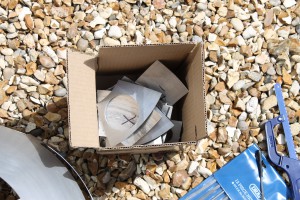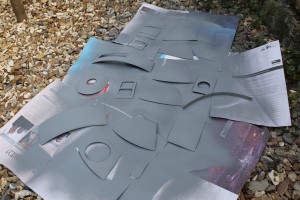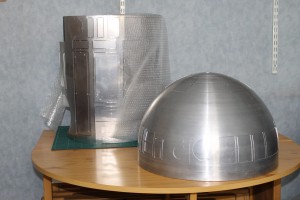Polishing the dome
The R2 dome that I got actually consists of 2 domes, one to fit inside the other. The outer one comes pre laser cut to make things easier, with all the various panels held on by a small tab of metal. A quick run with a file or fine hacksaw makes them a doddle to remove. Both domes are produced by a method called metal spinning, which means they have ‘spin lines’ running around them. This doesn’t matter for the blank inner dome as it is mostly hidden, but the outer dome needs the lines polishing out of it to get the correct look. This is a lot of work with wet and dry paper, going from a pretty coarse grit, up to some really fine paper.
Starting with the 240 grit and a large bottle of water, giving the dome a good sand down will remove the spin lines and make the surface rough, but even. Moving up through the different grit ratings slowly (very slowly) smooths the surface over until you get to the 3000 grit. The side product of this is silver hands!
It is all a slow and laborious process, but the end results are worth it. Whilst doing this work, the panels removed earlier needed painting, so a load of paper was laid out and the painting begun. I’ve been using Halfords car spray paints, starting with a grey primer to prep the surface, then a coat of Ford crystal blue, followed by Citroen poseidon blue, and finally a coat of laquer to protect it. It seems the trick is to do light coats, with a little bit of sanding in between with something like a 600 grit paper.
The end results look really good. I applied a little too thick in a few places, but its all a learning experience for me. I’ve just got a little more polishing to do on the dome, and I need to mask off most of it to let me spray the ring around the bottom of it blue. The next stage is to start cutting the inner dome to allow the panels to open and things to come out. I’m a little apprehensive about doing it, but once I’ve started it it will be fine. But for now, a taster of how it will look:








